The 9.7" iPad Pro Review
by Brandon Chester on June 1, 2016 9:00 AM ESTSystem Performance
Like the larger iPad Pro, the 9.7" iPad Pro uses Apple's A9X SoC. Apple is never very forthcoming with details like the clock speed for the CPU, GPU, and amount of DRAM. What we can determine about the SoC is that Apple has maintained the 2.2GHz maximum clock speed from the larger iPad Pro, while reducing clocks on the GPU and dropping to 2GB of LPDDR4 RAM.
The RAM situation on the 9.7" iPad Pro is somewhat surprising for a few different reasons. In their always-excellent teardown, the iFixit crew discovered that the smaller iPad Pro only had one Samsung 2GB LPDDR4 memory chip. This explains how Apple scaled down from 4GB to 2GB - the larger iPad Pro had two chips - but it also means that Apple has changed the amount of memory bandwidth available to the A9X SoC as well.
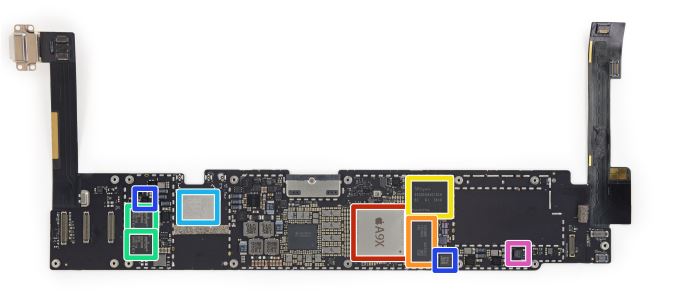
9.7" iPad Pro Logic Board (Image Courtesy iFixit)
To date, all Apple X-series SoCs have shipped with a larger 128-bit memory bus, and until now, Apple always fully populated that bus. So the 9.7" iPad Pro is an outlier in that regard, as this is the first time we've seen an X-series SoC with only the first 64-bit half wired up to a single memory chip in this fashion. In that respect it's a surprising decision from Apple, in part because of the importance of memory bandwidth in feeding the large, powerful GPUs on the X-series SoCs.
Consequently there is going to be more to the 9.7" iPad Pro than just the original Pro in a smaller chassis. The 9.7" iPad Pro should match the larger model in anything that depends heavily on CPU speed or memory bandwidth, while falling behind to some degree in GPU-bound tests. The 12 cluster PowerVR Series7XT GPU inside A9X will be having to make do with less memory bandwidth, though offset to some degree by the lower resolution of the screen.
With the above in mind, I quickly benchmarked the 9.7" iPad Pro on a couple of our memory bandwidth benchmarks. The results are somewhat inconclusive.
| Geekbench 3 Memory Bandwidth Comparison (1 thread) | ||||||
| Stream Copy | Stream Scale | Stream Add | Stream Triad | |||
| 9.7" iPad Pro | 17.1 GB/s | 11.5 GB/s | 12.9 GB/s | 12.8 GB/s | ||
| 12.9" iPad Pro | 20.8 GB/s | 15.0 GB/s | 15.3 GB/s | 15.1 GB/s | ||
I say "inconclusive" because although the 9.7" iPad Pro consistenly scores lower in Geekbench 3's memory bandwidth benchmarks and other memory benchmarks, it's never a 50% drop as we get on paper. In practice these numbers are far from the maximum memory bandwidth A9X is capable of, and I suspect that the CPU paths simply aren't wired in such a fashion that they can fully saturate A9X, especially given the fact that it's the GPU that needs the bandwidth more. So although we see some impact of the narrower memory bus in dedicated memory bandwidth benchmarks, these can't paint a very clear picture. It's going to be our high level GPU performance benchmarks that really give us an idea of the impact of reduced memory bandwidth.
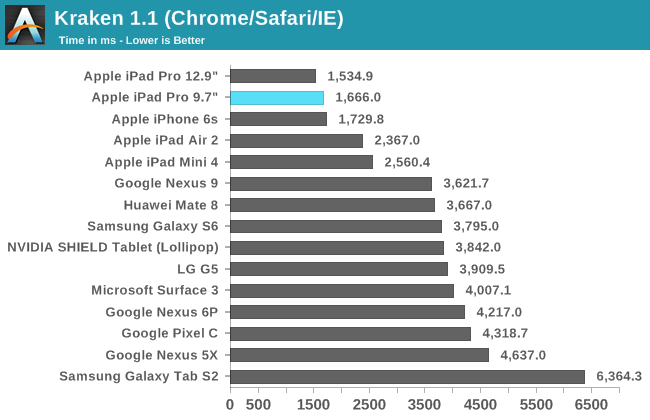
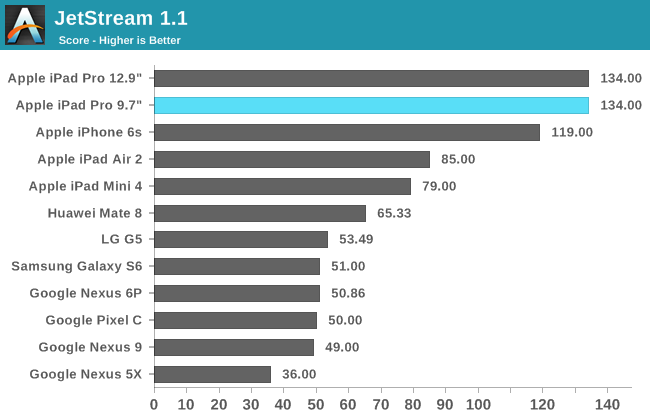
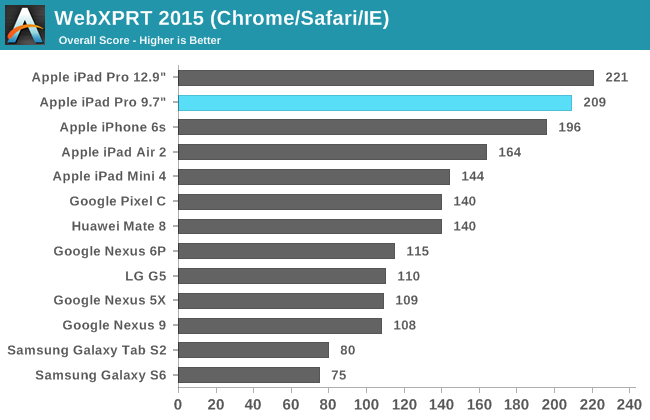
With the 9.7" iPad Pro having the same two 2.2GHz Apple Twister cores as the 12.9" model, it's no surprise to see the two neck and neck in our browser tests. In Jetstream 1.1 the two achieve the exact same score, while in the other two tests the 9.7" model is a bit slower, but with the gap being small enough to attribute to testing variance. With A9X Apple moved back to a dual-core CPU from A8X's tri-core CPU, with the move to TSMC's 16nm FinFET process allowing peak clock speeds to go up by 700MHz. Because JavaScript performance is mostly bound by a device's single threaded performance, A9X came with a significant performance uplift during web browsing. Given that the 12.9" iPad Pro offered the best web browsing performance of a mobile device, bringing that performance to the 9.7" iPad makes for a notable improvement over the performance of the iPad Air 2.
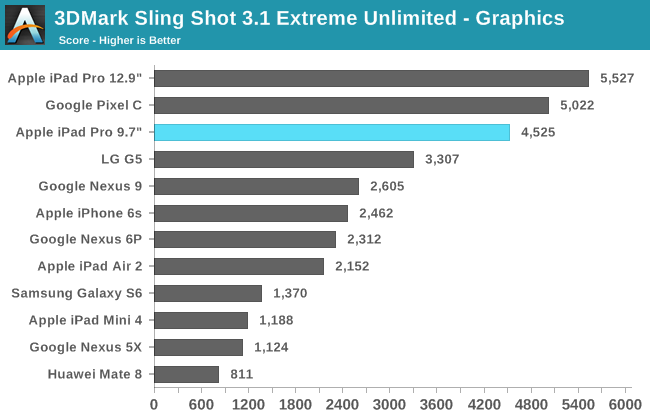
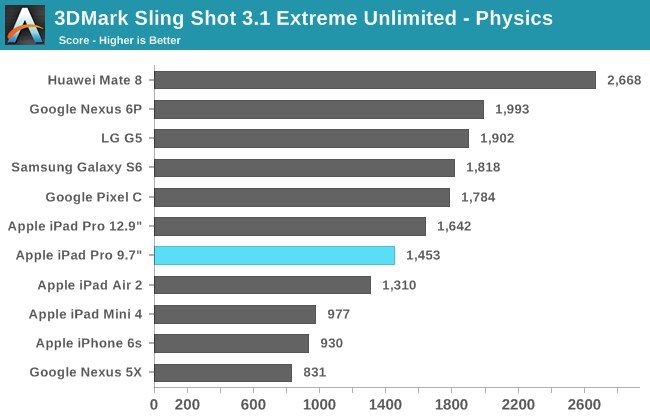

The 9.7" iPad Pro does well in 3DMark's graphics test, but like Ice Storm it doesn't do well in the physics test. It seems that this test is programmed in a similar way to Ice Storm, and in that sense I'm not sure how representative the physics test is of real-world performance because with an actual mobile game you wouldn't use highly random memory access and data structures with heavy memory dependencies when it would perform very poorly on your target devices. In any case, you can see that the 9.7" iPad Pro places third overall, with the 12.9" model at the top of the chart and the Pixel C coming right behind it.
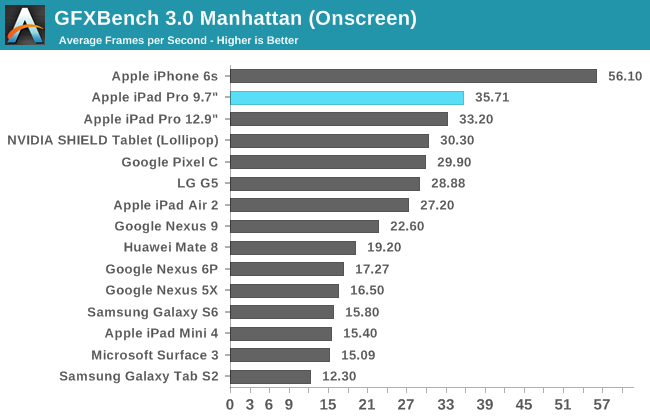
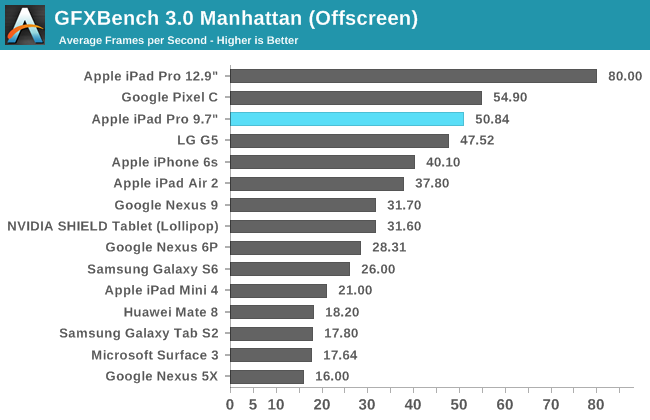
GFXBench 4.0 Car Chase hasn't made its way to iOS yet, and so for now we're still using GFXBench 3.0 Manhattan for iOS devices. Given that the iPhone 6s is the only phone that hits Vsync in this test, it's still a very relevant benchmark in how it represents the level of visual fidelity that a mobile game can currently have on high end devices while still performing well. In the off screen test we can see the impact of the 9.7" iPad Pro's lower clocked GPU combined with the reduced memory bandwidth,, with the smaller iPad performing around 37% lower than that of the 12.9" iPad Pro. The on screen test tells an interesting story though. Both models of the iPad Pro have roughly the same performance at their native resolutions in this test, which could indicate that Apple was targeting the same performance relative to the display resolution when configuring A9X and its memory, in order to manage heat and energy usage in a smaller iPad Pro.
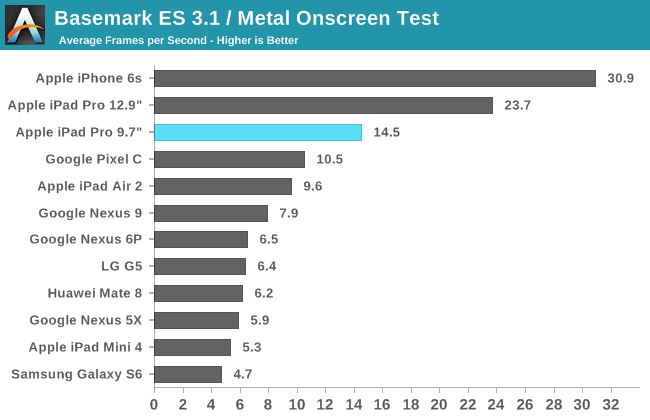
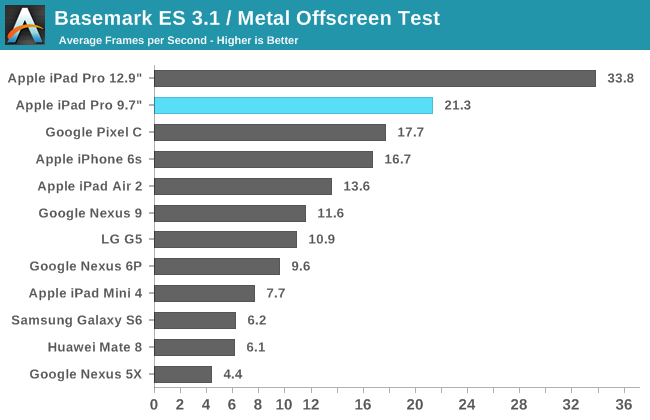
While I didn't have enough data to use BaseMark ES 3.1 at the time of my iPhone SE review, we've since tested enough older devices to deploy it. One could think of this as the successor to BaseMark X, which we retired some time ago before we officially deployed a new mobile test suite for 2016. Once again, both models of the iPad Pro sit above the other tablets on the chart. The iPhone 6s places first in the on screen test due to its relatively low resolution, but without that there the iPads would hold the top two spots in both tests.
NAND Performance
Something that Apple publicized with their A9 and A9X SoCs is improved NAND performance. NAND performance isn't discussed very much in reviews, but it's a very critical aspect of device performance and issues with it tend to cause a device's performance to crash months down the line rather than right off the bat, which makes it something of an invisible problem if you don't look for it during a review. We've seen previously that Apple has been using their own SSD controller in the current generation of iOS devices, and the 9.7" iPad Pro continues this.
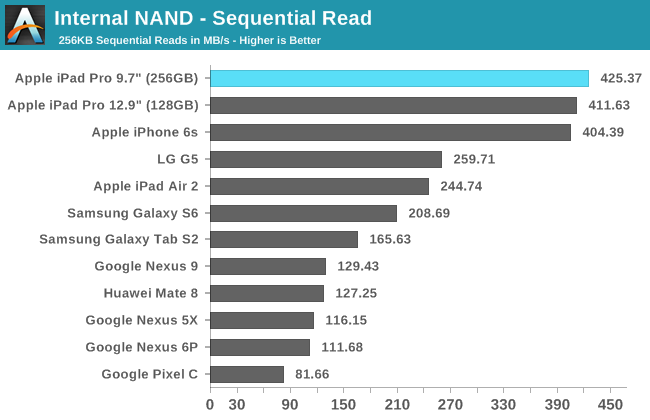
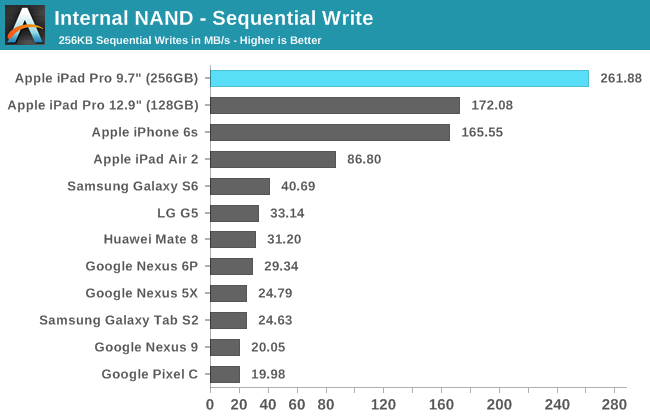
For this review I was sampled the 256GB model of the 9.7" iPad Pro. Because SSDs exploit parallelism heavily to improve performance, a 256GB iPad could improve NAND write performance over the lower-capacity models if it has a greater number of dies. In this case we see that sequential read performance improves a bit, while sequential writes improve dramatically as expected. There's not a lot to say here, as Apple has an enormous lead over the competition in this area.










144 Comments
View All Comments
Hal422 - Friday, June 10, 2016 - link
I tried the 12" iPad Pro with the Logitech Keyboard. Other than adding some weight to it they complement each other like family.I really like the paring, the functionality was remarkably like a laptop.
Having had the new Macbook for a while, I almost could not tell the difference except for the OS differences.
That aside, I am enjoying the 9.7' very much. It makes the iPad Air seem kind of kulnky in it's performance.
The screen size is identical to the iPad Air, as the Matt screen protector fit fine when switching them.
I really wish Logitech would reproduce the Logi Create for the little guy.
The sound on the 9.7" is at least 3 times as loud as the iPad Air, and very welcome.
The sound was deeper and better defined on the 12" Pro for the obvious size reasons.
I use the little iPad Pro daily and am trying to figure out who would best like to have my old iPad Air.
I am trying to like the Apple Pencil but there are some "Loss of Connection" issues and the Battery life lasts only around 2 days. There is no way to tell how low the battery on the Apple Pencil is getting until it quits on you. Come on Apple, you can show it with your Magic TrackPad. It would be nice to have an on and off switch on the Pencil as well.
I find myself using an old fashioned capacitive rubber stylus as it is always ready to use.
I have enough Win 10 devices to compare it to but Windows 10 is too buggy and nosey to use.
For my money I'm sticking with Apple for work and play.
alexb1 - Friday, June 24, 2016 - link
I got the 12.9" iPad Pro at work, and I absolutely HATE IT! It has ZERO use case for anyone who doesn't wanna draw on the iPad, and the size alone makes it completely poitnless. IF I wanted to carry a larger device with keyboard, WHY would I pick this iPad pro vs. a MacBook? or a Surface? There's zero added business value. iPad's selling point was its portability, ease of use, getting to your data quickly and not needing a keyboard... ALL of that is negated in the 12.9" ridiculous size.Now, I might get this iPad Pro, IF it was cheaper, as the price is absolutely outragous! Specially when someone add the Pencil and keyboard cost to it. It should have replaced Air 2, and should have been $100 cheaper and then it'd be the iPad of choice. It still doesn't offer any compelling reason for me to get rid of my iPad Air.
ragingfighter - Wednesday, July 13, 2016 - link
I agree there are definitely a lack of reasons for even me to consider an upgrade. If you have a generation one or two of the iPad Air you really don't need this device and less if you're opting for the better camera the under the hood performance increases and/or the true town display technology If you can live without this features this is definitely not for you. The assessories are or something that I do not consider too much. I consider it it's still a tablet and anything else is additional bogging down the base priceragingfighter - Wednesday, July 13, 2016 - link
I have sampled this tablet and I think it is really good I put it through its paces and it does keep up in general quite well. That being said though I still think you are an owner of the iPad Air generation one or beyond this is not necessarily an absolute need to upgrade. Unless if your iPad is your primary portable device which in some cases there are people that have them in this manner and have no laptop then you'll want the absolute best power and either you or go for this model or the higher 12.9 inch model. In this generation it's a conflict thing thing as this is why their first generations that introduce and actually larger iPad than the 9.7 in this generation it's a conflict thing thing as this is why their first generations that introduce and actually larger iPad than the 9.7 tier. If you are an iPad owner that has an iPad generation four or below and this may something to consider or even a second-generation iPad Air 2 myself I still think if you can get the iPad Air generation one for a good price it's more than I wore the tablet and you can save money beyond all the other models if you can pick it up for good price. You take a look at the upgrade path and it's Swithin mid tier of what apple has in their upgrade line iOS 10. Still have some time in it and it's still a very where the tablet. I don't think you could go wrong either way with that one or beyond